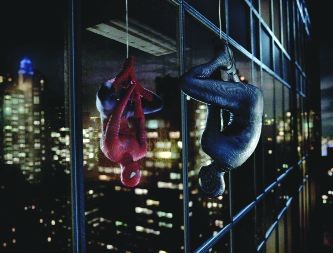Torn web

If you found the first two installments of the Spider-Man series poetic, imaginative and impassioned, you’re likely to experience an unpleasant jolt at Spider-Man 3. The first two pictures were built on beautifully worked-out fantasy scenarios that operated as metaphors for the emotional development of the main character, Peter Parker (Tobey Maguire), aka Spider-Man. The films took him from a gawky adolescence through physical and psychological loss (the murder of his uncle, the alienation of his best friend, Harry) into the beginning of an adult romance with aspiring actress M. J. Watson (Kirsten Dunst).
But this time the director, Sam Raimi, and his co-screenwriters, his brother Ivan and Alvin Sargent, have no compelling thematic ideas. They offer only a pile of supervillains for Spidey to deal with. Harry (James Franco) has taken on the persona of the Green Goblin, his unloving tyrant father, whose death Harry blames on Peter. An escaped thief (Thomas Haden Church) caught in a sand silo during a physics experiment is transformed into a monster called Sandman. And a wriggling inky parasite from outer space that lands in a crater near the spot where Peter and M. J. are spooning on one of his webs—one of the few memorable images in the film—attaches itself to Peter and later to one of the other characters, in both cases intensifying aggressive impulses.
There is some kind of idea here: Spider-Man’s celebrity has made him cocky and vain. The sticky extraterrestrial substance that turns his suit to metallic black is an exaggeration of the unpleasant qualities he has taken on. And he becomes addicted to the way the suit makes him feel. But the story is not convincing; it feels tacked onto the Spider-Man narrative.
Maguire struggles to balance Peter’s self-absorption and insensitivity with the sweetness and romantic soulfulness that he brought to the first two movies. But the new Peter isn’t plausible. Neither is much of the plotting, including the way the writers negotiate Harry’s metamorphosis at the 11th hour. Spider-Man 3 has the lumpy feel of an obligatory sequel. The movie lurches from scene to scene, often relying on coincidences to bring characters together or put them in the way of oncoming disasters.
The actor who elicits the most sympathy is Dunst. Her first interaction with Maguire in Spider-Man 2 was layered with emotional crosscurrents. This time the writers have boiled M. J. down to one emotion at a time—practically one emotion for the whole picture (she’s depressed). And since Raimi is an actor’s director and instinctively focuses on feeling, you’re always aware of the reduced emotional palette in a way that you wouldn’t be in a flashy superhero saga made by a hack. As in the earlier entries in the series, he provides multiple close-ups to keep us in touch with what’s going on inside the characters. Some of the actors, like Church and Franco and the sublime Rosemary Harris, repeating her role as Peter’s Aunt May, make the most of these moments, but they’re dots on a landscape that lacks cohesion and depth.
Raimi and the other writers must have known the movie wasn’t coming together. There’s a desperate quality to some of the items they toss in, such as a maître d’ whose French accent is a second-generation copy of Peter Sellers’s voice as Inspector Clouseau, and an acrobatic dance number by Parker, shot into overdrive by the alien parasite, in a jazz club where M. J. finds a job after a Broadway company sacks her. (The movie implies that this second-rate gig is the best M. J. can land, but it looks like a pretty nice place, and she’s the headliner.)
Even the action sequences lack distinction, especially the ones involving Sandman, whose monolithic visual presence isn’t much to look at. None of the elements we’ve grown to love about the series is presented in top form in this sadly disappointing film.





